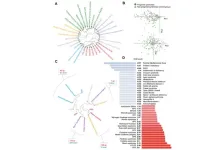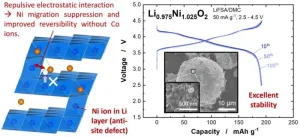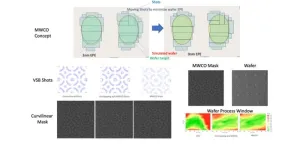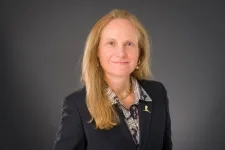(Press-News.org) By Beth Miller
Two teams of engineers led by faculty in the McKelvey School of Engineering at Washington University in St. Louis will work toward developing products to monitor drinking water quality and to detect explosives with an electronic nose with one-year, $650,000 Convergence Accelerator Phase 1 grants from the National Science Foundation (NSF).
Barani Raman, professor of biomedical engineering, and Daniel Giammar, the Walter E. Browne Professor of Environmental Engineering, will lead teams of researchers from Washington University and other institutions and entities funded under the NSF’s Convergence Accelerator program, designed to address national-scale societal challenges through convergence research and to transition basic research and discovery into practice to solve these challenges aligned with specific research themes. Among the themes are real-world chemical sensing applications, bio-inspired design innovations and equitable water solutions.
Raman and his collaborators have been working for nearly two decades to harness insects’ keen sense of smell into a sensor that could be used to detect explosives and in other applications. Now, they will take it a step further by incorporating artificial intelligence (AI) and nanotechnology to create a sensor, or electronic nose, to detect explosive volatile organic compounds.
Raman, professor of biomedical engineering, will work with longtime McKelvey Engineering collaborators Shantanu Chakrabartty, the Clifford W. Murphy Professor in the Preston M. Green Department of Electrical & Systems Engineering; Srikanth Singamaneni, the Lilyan & E. Lisle Hughes Professor in the Department of Mechanical Engineering & Materials Science; and Braden Giordano, associate superintendent of the Chemistry Division at the U.S. Naval Research Laboratory.
Using the information gathered from their research in developing bio-inspired sensors, the team plans to create an AI-enabled, nanoparticle-based electronic nose device that can be used to gather and validate data. This portable proof-of-concept device would merge two ideas: a large, nanostructured chemical sensor array with diverse functions and the sensing and AI principles it has identified in the olfactory system of locusts. With the data, they plan to develop a library of known signatures for various explosive vapors at various concentration ranges.
In addition to detecting volatile organic compounds, the electronic nose could also be used in biomedicine, homeland security, environmental monitoring, climate change technologies and the flavor and food industry. The team plans to work with industry partners to tailor the design for various uses.
“A decade ago, we did not yet have the technology to develop a field-deployable and robust electronic nose,” Raman said. “The recent advances in biological olfaction, combined with developments in materials science and electronics for remote and long-term monitoring, helped us to understand the computing principles in biological olfaction. In addition, the vast improvements in AI, machine learning and data science provided a new opportunity to develop a robust artificial chemical sensing system.”
Raman acknowledges that a device equal in capabilities as a biological olfactory system such as the locust’s is a Holy Grail. However, this new work and design plan will consider the key requirements in various applications and develop priorities of capabilities needed in the electronic nose technology.
In the second McKelvey Engineering-led Convergence Accelerator project, Giammar, also the director of the university’s Center for the Environment, will lead a team in developing a drinking water-quality monitoring tool based on point-of-use water filters. The research will focus on residents of disadvantaged communities served by small public water systems and those in urban locations served by large water systems with an aging infrastructure as well as those who source water from private wells with lower monitoring requirements.
The team will evaluate the ability of commercially available point-of-use filters, such as faucet-mounted filters, to monitor copper, zinc, manganese, hexavalent chromium, arsenic, microorganisms, and per- and polyfluorinated alkyl substances, or PFAS, the widely used “forever chemicals” linked with harm to the environment and to human health.
“In urban settings, recent crises with lead found in drinking water in Flint, Michigan, and Newark, New Jersey, highlight the threats to public health posed by aging water supply infrastructure,” Giammar said. “The existing monitoring framework is often not enough to identify degraded water quality for those populations most affected, making this an environmental justice issue as much as a water quality issue.”
Giammar’s team includes co-principal investigators from WashU, including Fangqiong Ling and Kimberly Parker, both assistant professors of energy, environmental & chemical engineering in McKelvey Engineering, and Joe Steensma, professor of practice at the Brown School; as well as researchers from the University of Illinois at Urbana-Champaign, including Steven Wilson, groundwater hydrologist and principal scientist for the Illinois State Water Survey, Thanh Huong Nguyen, the Ivan Racheff Professor of Environmental Engineering in Civil & Environmental Engineering, and John Scott, senior analytical chemist in the Illinois Sustainable Technology Center.
Giammar’s project also has external partners, including the Midwest Assistance Program, the Rural Community Assistance Partnership, the Water Quality Association, and the U.S. Environmental Protection Agency.
END
Water quality monitor, locust-inspired electronic nose under development
Teams led by Barani Raman, Dan Giammar awarded $650,000 National Science Foundation Convergence Accelerator grants
2024-02-21
ELSE PRESS RELEASES FROM THIS DATE:
Child tax credits provided significant relief to families experiencing economic shocks during COVID
2024-02-21
Contact:
Jillian McKoy, jpmckoy@bu.edu
Michael Saunders, msaunder@bu.edu
##
As a proposal to reinstate expanded Child Tax Credits (CTC) in the United States awaits a vote in the Senate, a new study led by Boston University School of Public Health (BUSPH) researchers reveals that the now-expired 2021 CTC expansion benefitted families experiencing financial setbacks due to health or employment challenges spurred by the COVID-19 pandemic.
Published in the journal Health Affairs Scholar, the study found that monthly advance payments included in the 2021 CTC ...
Plasma scientists develop computer programs that could reduce the cost of microchips and stimulate American manufacturing
2024-02-21
Fashioned from the same element found in sand and covered by intricate patterns, microchips power smartphones, augment appliances and aid the operation of cars and airplanes. Now, scientists at the U.S. Department of Energy’s (DOE) Princeton Plasma Physics Laboratory (PPPL) are developing computer simulation codes that will outperform current simulation techniques and aid the production of microchips using plasma, the electrically charged state of matter also used in fusion research. These codes could help increase the efficiency of the manufacturing process and potentially stimulate ...
Novel combination therapy offers promising results for treatment-refractory hepatoblastoma
2024-02-21
Hepatoblastoma (HB) is the most common liver cancer in children. Researchers and physicians in the field are concerned because in the last decade HB has been rising rapidly worldwide and has seen the most rapid increase among all pediatric solid tumors.
A team led by researchers at Baylor College of Medicine has been working on improving therapies for this devastating disease. They recently reported in the Journal of Hepatology a novel treatment strategy that produced encouraging results in animal models.
“High-risk disease leads to high rates of relapse and mortality,” said first author Dr. Andrés F. Espinoza, general ...
New study: Defining the progeria phenome
2024-02-21
“In sum, we have defined what a premature aging disease is and developed tools to allow diagnostics of patients and disease population.”
BUFFALO, NY- February 20, 2024 – A new research paper was published in Aging (listed by MEDLINE/PubMed as "Aging (Albany NY)" and "Aging-US" by Web of Science) Volume 16, Issue 3, entitled, “Defining the progeria phenome.”
Progeroid disorders are a heterogenous group of rare and complex hereditary syndromes presenting with pleiotropic phenotypes associated with normal aging. Due to the ...
Low oxygen in lakes may breathe new life into conservation efforts for water quality
2024-02-21
Abigail Lewis traveled all across the United States for college and graduate school, and she ended up researching lakes in her own hometown.
For one of her graduate research projects, Lewis analyzed 656 lakes across five continents with an international research team. The lakes in her hometown of Waukesha, Wisconsin, were among those included.
“To look back and pull together these two parts of my life has been really satisfying,” said Lewis, who will earn her Ph.D. in biological sciences this spring.
In a paper recently published in Global Change Biology, ...
Engineering a coating for disease-free produce
2024-02-21
Dr. Mustafa Akbulut, professor of chemical engineering, has teamed up with horticultural science professor Luis Cisneros-Zevallos to engineer longer-lasting, bacteria-free produce.
According to Akbulut’s recent publication in Current Research in Food Science, the global fruit and vegetable market loses over 50% of agricultural fruit production during various stages of produce handling and post-harvest treatments.
Many fruits and vegetables already have a layer of food-grade wax that is applied for cosmetic reasons and to prevent water loss. Akbulut’s research combines such wax with nano-encapsulated cinnamon-bark ...
Ochsner Children’s Hospital advocates to close the gap in pediatric heart care
2024-02-21
NEW ORLEANS, LA - Ochsner Children's Hospital, ranked among the top hospitals in the nation for pediatric cardiology and congenital heart surgery, is raising awareness of the need for more pediatric-specific heart devices. As the only pediatric heart transplant program in Louisiana and the only program in the state to offer advanced mechanical support options for pediatric cardiology patients, Ochsner Children’s Hospital is committed to advocating for additional medical devices to enhance its high-quality care to pediatric patients ...
Cobalt-free electrodes achieved with nickel ions
2024-02-20
Many electric vehicles are powered by lithium-ion batteries that rely on cobalt — a scarce, expensive metal with high environmental and social costs. A team of researchers from Japanese and French universities have now developed a practical nickel-based electrode material that opens new avenues to cobalt-free batteries for electric vehicles.
The researchers detailed their findings in a study published on Jan. 15 in the journal Energy Storage Materials.
“There is an undeniable need for cobalt-free, high-energy electrode materials for lithium-ion ...
Throwing lithography a curve
2024-02-20
At the heart of advancing semiconductor chip technology lies a critical challenge: creating smaller, more efficient electronic components. This challenge is particularly evident in the field of lithography, the process used to create intricate patterns on semiconductor materials (called wafers) for the production of chips. Lithography uses a kind of template, called a photomask — or just mask — for creating patterns on semiconductor wafers. The industry is always looking for methods that improve resolution and manufacturability for both masks and ...
St. Jude taps health care start-up veteran as first Senior Vice President of Tech Commercialization
2024-02-20
(MEMPHIS, Tenn., February 20, 2024) St. Jude Children’s Research Hospital has appointed Lisa Jordan, MS, MBA, as the institution’s first-ever Senior Vice President of Technology Commercialization to lead industry partnerships and the commercialization of innovations. Jordan will work with researchers to bring a greater number of new technologies, innovations and scientific breakthroughs to the clinic, enabling breakthroughs from St. Jude laboratories to benefit more patients.
The move, part of the institution’s 2022-2027 ...
LAST 30 PRESS RELEASES:
Making lighter work of calculating fluid and heat flow
Normalizing blood sugar can halve heart attack risk
Lowering blood sugar cuts heart attack risk in people with prediabetes
Study links genetic variants to risk of blinding eye disease in premature infants
Non-opioid ‘pain sponge’ therapy halts cartilage degeneration and relieves chronic pain
AI can pick up cultural values by mimicking how kids learn
China’s ecological redlines offer fast track to 30 x 30 global conservation goal
Invisible indoor threats: emerging household contaminants and their growing risks to human health
Adding antibody treatment to chemo boosts outcomes for children with rare cancer
Germline pathogenic variants among women without a history of breast cancer
Tanning beds triple melanoma risk, potentially causing broad DNA damage
Unique bond identified as key to viral infection speed
Indoor tanning makes youthful skin much older on a genetic level
Mouse model sheds new light on the causes and potential solutions to human GI problems linked to muscular dystrophy
The Journal of Nuclear Medicine ahead-of-print tip sheet: December 12, 2025
Smarter tools for peering into the microscopic world
Applications open for funding to conduct research in the Kinsey Institute archives
Global measure underestimates the severity of food insecurity
Child survivors of critical illness are missing out on timely follow up care
Risk-based vs annual breast cancer screening / the WISDOM randomized clinical trial
University of Toronto launches Electric Vehicle Innovation Ontario to accelerate advanced EV technologies and build Canada’s innovation advantage
Early relapse predicts poor outcomes in aggressive blood cancer
American College of Lifestyle Medicine applauds two CMS models aligned with lifestyle medicine practice and reimbursement
Clinical trial finds cannabis use not a barrier to quitting nicotine vaping
Supplemental nutrition assistance program policies and food insecurity
Switching immune cells to “night mode” could limit damage after a heart attack, study suggests
URI-based Global RIghts Project report spotlights continued troubling trends in worldwide inhumane treatment
Neutrophils are less aggressive at night, explaining why nighttime heart attacks cause less damage than daytime events
Menopausal hormone therapy may not pose breast cancer risk for women with BRCA mutations
Mobile health tool may improve quality of life for adolescent and young adult breast cancer survivors
[Press-News.org] Water quality monitor, locust-inspired electronic nose under developmentTeams led by Barani Raman, Dan Giammar awarded $650,000 National Science Foundation Convergence Accelerator grants





